高中英语语法 冠词讲解及练习
高中冠词专项讲解与练习(含答案解析)
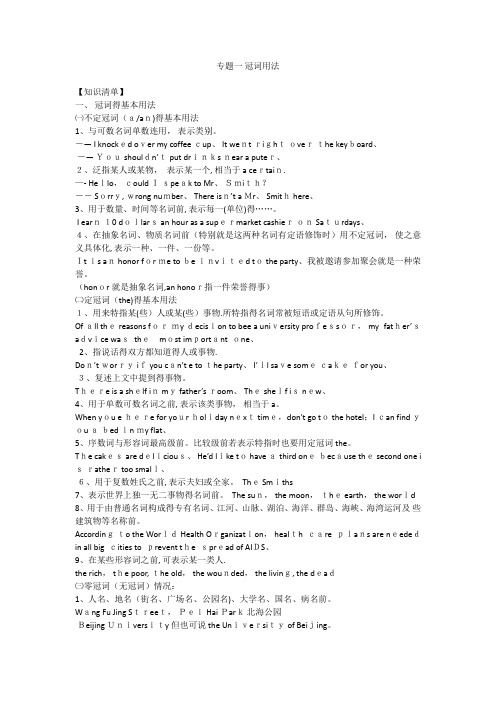
专题一冠词用法【知识清单】一、冠词得基本用法㈠不定冠词(a/an)得基本用法1、与可数名词单数连用,表示类别。
-— I knocked over my coffee cup、 It went rightoverthe keyboard、-—You shouldn’t put drinks near a puter、2、泛指某人或某物,表示某一个, 相当于 a certain.—- Hello,could Ispeak to Mr、Smith?-- Sorry, wrong number、 There isn’t a Mr、 Smith here、3、用于数量、时间等名词前, 表示每一(单位)得……。
I earn10 dollars an hour as a supermarket cashieron Saturdays、4、在抽象名词、物质名词前(特别就是这两种名词有定语修饰时)用不定冠词,使之意义具体化, 表示一种、一件、一份等。
It is an honor for me to be invited to the party、我被邀请参加聚会就是一种荣誉。
(honor就是抽象名词,an honor指一件荣誉得事)㈡定冠词(the)得基本用法1、用来特指某(些)人或某(些)事物.所特指得名词常被短语或定语从句所修饰。
Of all the reasons formy decision to bee a university professor, my father’sadvice wasthemost important one、2、指说话得双方都知道得人或事物.Don’t worry if you can’t e to the party、 I’ll save somecakefor you、3、复述上文中提到得事物。
There is a shelf in myfather’sroom、 The shelf is new、4、用于单数可数名词之前, 表示该类事物,相当于 a。
(英语)高中英语冠词及其解题技巧及练习题(含答案)含解析
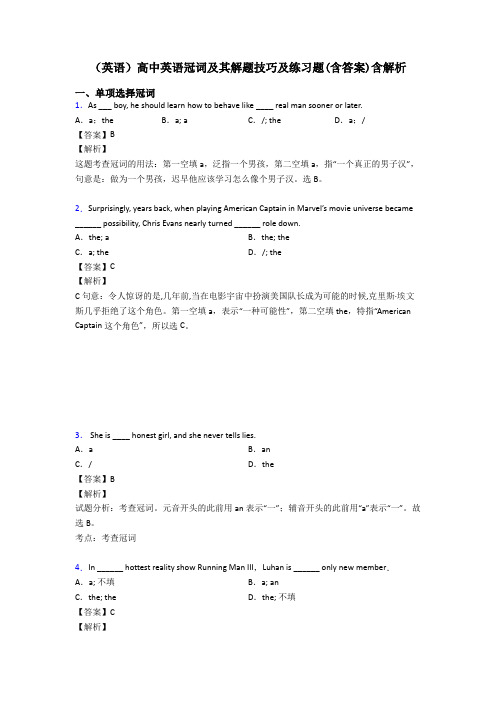
(英语)高中英语冠词及其解题技巧及练习题(含答案)含解析一、单项选择冠词1.As ___ boy, he should learn how to behave like ____ real man sooner or later.A.a;the B.a; a C./; the D.a;/【答案】B【解析】这题考查冠词的用法:第一空填a,泛指一个男孩,第二空填a,指“一个真正的男子汉”,句意是:做为一个男孩,迟早他应该学习怎么像个男子汉。
选B。
2.Surprisingly, years ba ck, when playing American Captain in Marvel’s movie universe became ______ possibility, Chris Evans nearly turned ______ role down.A.the; a B.the; theC.a; the D./; the【答案】C【解析】C句意:令人惊讶的是,几年前,当在电影宇宙中扮演美国队长成为可能的时候,克里斯·埃文斯几乎拒绝了这个角色。
第一空填a,表示“一种可能性”,第二空填the,特指“American Captain这个角色”,所以选C。
3. She is ____ honest girl, and she never tells lies.A.a B.anC./ D.the【答案】B【解析】试题分析:考查冠词。
元音开头的此前用an表示“一”;辅音开头的此前用“a”表示“一”。
故选B。
考点:考查冠词4.In ______ hottest reality show Running Man III,Luhan is ______ only new member.A.a; 不填B.a; anC.the; the D.the; 不填【答案】C【解析】分析句子,可知前后两个空格都是特指的,故用定冠词the。
冠词用法及专项练习(含答案)
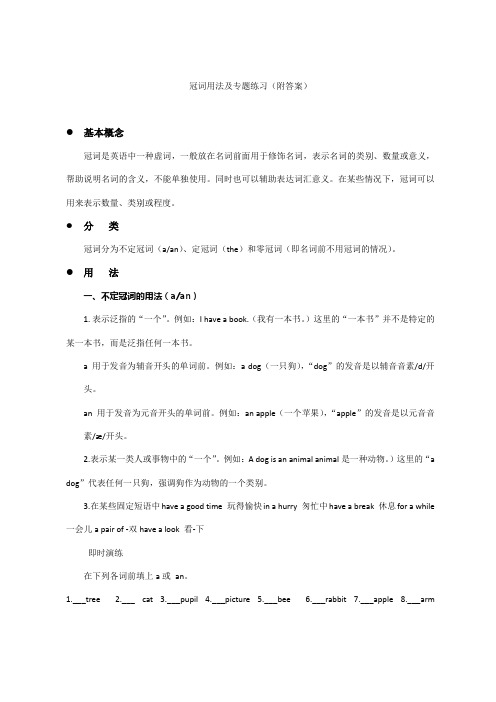
冠词用法及专题练习(附答案)●基本概念冠词是英语中一种虚词,一般放在名词前面用于修饰名词,表示名词的类别、数量或意义,帮助说明名词的含义,不能单独使用。
同时也可以辅助表达词汇意义。
在某些情况下,冠词可以用来表示数量、类别或程度。
●分类冠词分为不定冠词(a/an)、定冠词(the)和零冠词(即名词前不用冠词的情况)。
●用法一、不定冠词的用法(a/an)1.表示泛指的“一个”。
例如:I have a book.(我有一本书。
)这里的“一本书”并不是特定的某一本书,而是泛指任何一本书。
a 用于发音为辅音开头的单词前。
例如:a dog(一只狗),“dog”的发音是以辅音音素/d/开头。
an 用于发音为元音开头的单词前。
例如:an apple(一个苹果),“apple”的发音是以元音音素/æ/开头。
2.表示某一类人或事物中的“一个”。
例如:A dog is an animal animal是一种动物。
)这里的“a dog”代表任何一只狗,强调狗作为动物的一个类别。
3.在某些固定短语中have a good time 玩得愉快in a hurry 匆忙中have a break 休息for a while 一会儿a pair of -双have a look 看-下即时演练在下列各词前填上a或an。
1.___tree2.___ cat3.___pupil4.___picture5.___bee6.___rabbit7.___apple8.___arm9.___kitchen 10.___dog 11.___orange 12.___uniform 13.___unit 14.___hour 15.___honest man16.___English boy 17.___European girl 18.___university二、定冠词(the)的用法1.表示特指。
即指特定的人或事物。
例如:The book on the table is mine.(桌子上的那本书是我的。
(完整版)高中英语语法讲解与练习
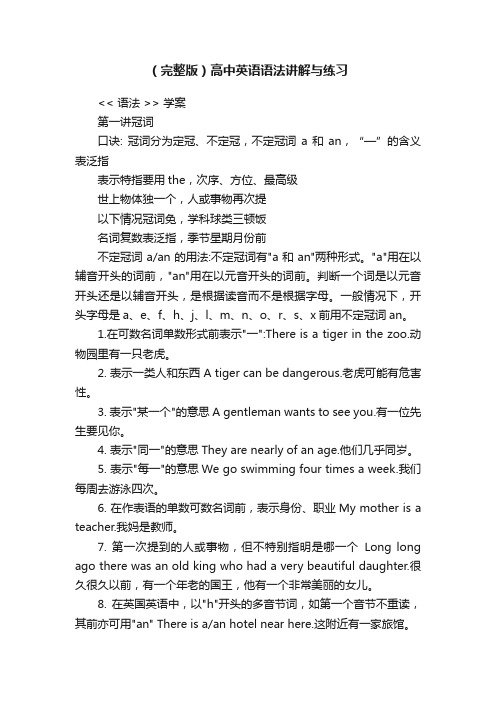
(完整版)高中英语语法讲解与练习<< 语法 >> 学案第一讲冠词口诀: 冠词分为定冠、不定冠,不定冠词a和an,“—”的含义表泛指表示特指要用the,次序、方位、最高级世上物体独一个,人或事物再次提以下情况冠词免,学科球类三顿饭名词复数表泛指,季节星期月份前不定冠词a/an的用法:不定冠词有"a和an"两种形式。
"a"用在以辅音开头的词前,"an"用在以元音开头的词前。
判断一个词是以元音开头还是以辅音开头,是根据读音而不是根据字母。
一般情况下,开头字母是a、e、f、h、j、l、m、n、o、r、s、x前用不定冠词an。
1.在可数名词单数形式前表示"一":There is a tiger in the zoo.动物园里有一只老虎。
2. 表示一类人和东西 A tiger can be dangerous.老虎可能有危害性。
3. 表示"某一个"的意思A gentleman wants to see you.有一位先生要见你。
4. 表示"同一"的意思They are nearly of an age.他们几乎同岁。
5. 表示"每一"的意思We go swimming four times a week.我们每周去游泳四次。
6. 在作表语的单数可数名词前,表示身份、职业My mother is a teacher.我妈是教师。
7. 第一次提到的人或事物,但不特别指明是哪一个Long long ago there was an old king who had a very beautiful daughter.很久很久以前,有一个年老的国王,他有一个非常美丽的女儿。
8. 在英国英语中,以"h"开头的多音节词,如第一个音节不重读,其前亦可用"an" There is a/an hotel near here.这附近有一家旅馆。
冠词用法 及习题 附参考答案
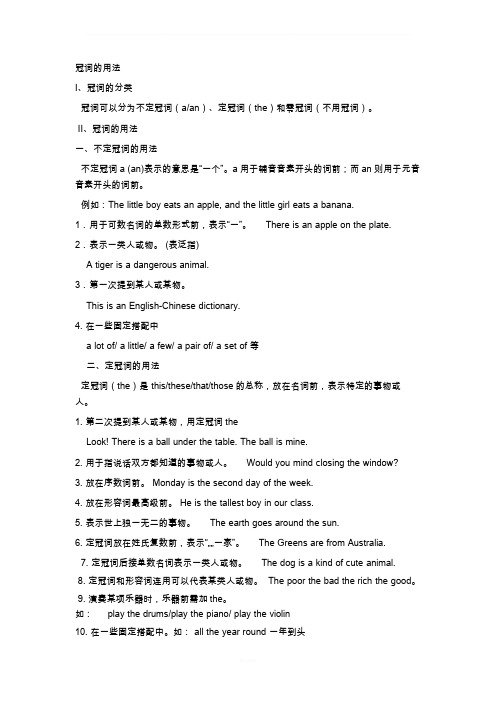
冠词的用法I、冠词的分类冠词可以分为不定冠词(a/an)、定冠词(the)和零冠词(不用冠词)。
II、冠词的用法一、不定冠词的用法不定冠词a(an)表示的意思是“一个”。
a用于辅音音素开头的词前;而an则用于元音音素开头的词前。
例如:The little boy eats an apple,and the little girl eats a banana.1.用于可数名词的单数形式前,表示“一”。
There is an apple on the plate.2.表示一类人或物。
(表泛指)A tiger is a dangerous animal.3.第一次提到某人或某物。
This is an English-Chinese dictionary.4.在一些固定搭配中a lot of/a little/a few/a pair of/a set of等二、定冠词的用法定冠词(the)是this/these/that/those的总称,放在名词前,表示特定的事物或人。
1.第二次提到某人或某物,用定冠词theLook!There is a ball under the table.The ball is mine.2.用于指说话双方都知道的事物或人。
Would you mind closing the window?3.放在序数词前。
Monday is the second day of the week.4.放在形容词最高级前。
He is the tallest boy in our class.5.表示世上独一无二的事物。
The earth goes around the sun.6.定冠词放在姓氏复数前,表示“……一家”。
The Greens are from Australia.7.定冠词后接单数名词表示一类人或物。
The dog is a kind of cute animal.8.定冠词和形容词连用可以代表某类人或物。
高中冠词练习题及讲解及答案

高中冠词练习题及讲解及答案1. There is _______ "s" in the word "useful."A. aB. theC. anD. /2. _______ Great Wall is one of the greatest wonders of the world.A. AB. AnC. TheD. /3. She has _______ uncle who is a famous scientist.A. aB. anC. theD. /4. _______ old man is sitting on the bench.A. AB. AnC. TheD. /5. _______ every student in our class likes English.A. AB. AnC. TheD. /6. _______ Smiths are going to have a holiday in Australia.A. AB. AnC. TheD. /7. _______ honest boy he is!A. What aB. What anC. WhatD. /8. _______ university where he studied is famous for its engineering program.A. AB. AnC. TheD. /9. _______ Internet has made our life more convenient.A. AB. AnC. TheD. /10. _______ United States is a country in North America.A. AB. AnC. TheD. /讲解冠词是英语中用来修饰名词的词,分为不定冠词(a/an)和定冠词(the)。
不定冠词用于表示数量上的“一”,而定冠词用于特指某个或某些特定的事物。
(完整版)冠词练习题及答案
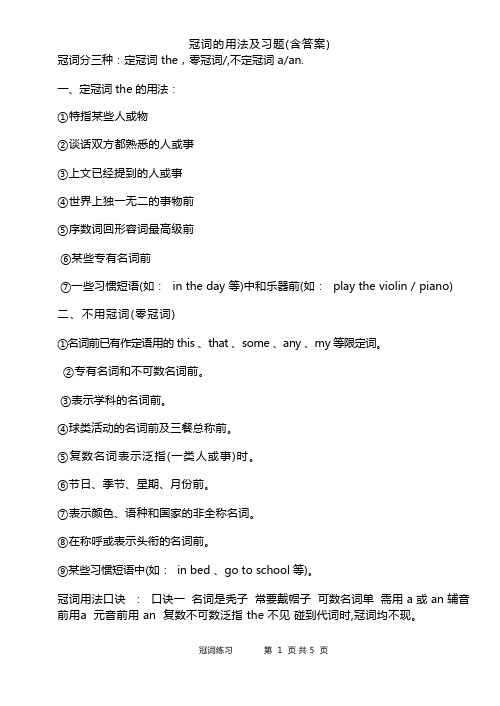
冠词的用法及习题(含答案)冠词分三种:定冠词 the,零冠词/,不定冠词 a/an.一、定冠词 the 的用法:①特指某些人或物②谈话双方都熟悉的人或事③上文已经提到的人或事④世界上独一无二的事物前⑤序数词回形容词最高级前⑥某些专有名词前⑦一些习惯短语(如: in the day 等)中和乐器前(如: play the violin / piano) 二、不用冠词(零冠词)①名词前已有作定语用的 this 、that 、some 、any 、my 等限定词。
②专有名词和不可数名词前。
③表示学科的名词前。
④球类活动的名词前及三餐总称前。
⑤复数名词表示泛指(一类人或事)时。
⑥节日、季节、星期、月份前。
⑦表示颜色、语种和国家的非全称名词。
⑧在称呼或表示头衔的名词前。
⑨某些习惯短语中(如: in bed 、go to school 等)。
冠词用法口诀:口诀一名词是秃子常要戴帽子可数名词单需用 a 或 an 辅音前用a 元音前用 an 复数不可数泛指 the 不见碰到代词时,冠词均不现。
第 1 页共 5 页口诀二(定冠词) 特指双熟悉上文已提及世上独无二序数最高级某些专有名习语和乐器。
口诀三(零冠词) 代词限定名词前专有名词不可数学科球类三餐饭两季星期月份前颜色语种和国名称呼习语和头衔。
一、基础题1. There is _______ house in the picture. There is ________old woman near______ house.A. an; a; theB. a; an ; theC. the ; a; anD. a; the; an2. He has already worked for ______ hour.A. theB. anC. aD. 不填3. Alice is fond of playing ______ piano.A. theB. anC. aD. 不填4. Beyond ____ stars, the astronaut saw nothing but _____space.A. 不填; theB. the ; theC. 不填,不填D. the; 不填5.______terrible weather we’ve been having these days!A. How aB. What aC. HowD. What6. —Where is Jack?— I think he is still in ______ bed, but he might just be in ______bathroom.A. 不填;不填B. the; theC. the;不填D. 不填; the7.When do you have _____breakfast every day?A. aB. anC. theD. 不填8. Many people are still in _____ habit of writing silly things in ______public places.A. the ; 不填B. 不填 ; theC. the ; theD. 不填; 不填二、加强题在空白处填入/ 、a 、an 或 the。
专题03.冠词考点梳理(复习讲义)原卷版

专题03.冠词考点梳理(复习讲义)考点清单范围知识条目冠词掌握冠词a(an),the和零冠词的基本用法考点一冠词a,an,the和零冠词的基本用法冠词主要放在名词之前,说明名词所表示的人或事物。
它不能离开名词而单独存在。
冠词有三种:a和an为不定冠词,the为定冠词,零冠词(名词前不用冠词)。
一、不定冠词a/an的用法1.用于第一次提到的某人或某物前。
如:This is a book.2.泛指人或事物的某一类别。
如:A plane is a machine.3.泛指某人或某物。
如:A girl is waiting for you.4.用于表示时间、速度、价格等意义的名词之前,有“每一”的意思,相当于every。
如:five lessons a week5.用在某些物质名词或抽象名词前,表示“一阵、一份、一类、一场”等。
如:There’ll be a strong wind in South China.6.用于可视为一个整体的两个名词前。
如:a knife and fork一副刀叉7.不定冠词a,an的区别a用在读音以辅音音素开头的单词前,an用在以元音音素开头的单词前。
判断一个词是以元音开头还是辅音开头,是根据其读音,而不是根据其首字母。
如:an honest boy要注意区别以u开头的单词。
an umbrella,an unusual story,an unhappy boy,a university,a useful book二、定冠词the的用法1.用于双方都知道的人或事物前。
如:Give me the book,please.2.特指上文已提到过的人或事物。
如:Tom bought a book,and the book was written by Lu Xun.3.表示世界上独一无二的事物。
如:The earth moves around the sun.4.用在序数词、形容词最高级前面,以及对两个人或事物进行比较时起特指作用的比较级前。
超实用高考英语复习:高考语法填空抢分热点之冠词(解析版)
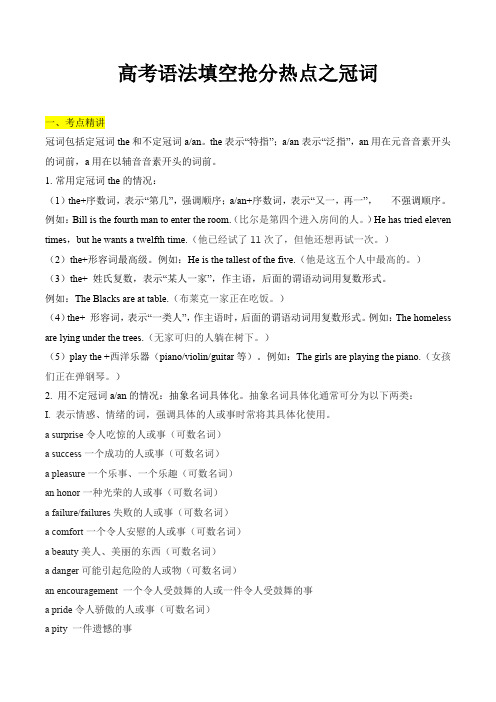
高考语法填空抢分热点之冠词一、考点精讲冠词包括定冠词the和不定冠词a/an。
the表示“特指”;a/an表示“泛指”,an用在元音音素开头的词前,a用在以辅音音素开头的词前。
1.常用定冠词the的情况:(1)the+序数词,表示“第几”,强调顺序;a/an+序数词,表示“又一,再一”,不强调顺序。
例如:Bill is the fourth man to enter the room.(比尔是第四个进入房间的人。
)He has tried eleven times,but he wants a twelfth time.(他已经试了11次了,但他还想再试一次。
)(2)the+形容词最高级。
例如:He is the tallest of the five.(他是这五个人中最高的。
)(3)the+ 姓氏复数,表示“某人一家”,作主语,后面的谓语动词用复数形式。
例如:The Blacks are at table.(布莱克一家正在吃饭。
)(4)the+ 形容词,表示“一类人”,作主语时,后面的谓语动词用复数形式。
例如:The homeless are lying under the trees.(无家可归的人躺在树下。
)(5)play the +西洋乐器(piano/violin/guitar等)。
例如:The girls are playing the piano.(女孩们正在弹钢琴。
)2. 用不定冠词a/an的情况:抽象名词具体化。
抽象名词具体化通常可分为以下两类:I. 表示情感、情绪的词,强调具体的人或事时常将其具体化使用。
a surprise令人吃惊的人或事(可数名词)a success一个成功的人或事(可数名词)a pleasure一个乐事、一个乐趣(可数名词)an honor一种光荣的人或事(可数名词)a failure/failures失败的人或事(可数名词)a comfort一个令人安慰的人或事(可数名词)a beauty美人、美丽的东西(可数名词)a danger可能引起危险的人或物(可数名词)an encouragement 一个令人受鼓舞的人或一件令人受鼓舞的事a pride令人骄傲的人或事(可数名词)a pity 一件遗憾的事a threat 一个构成威胁的人或事物His hope has become a reality.(他的希望变成了现实)It’s a great help to me.(这对我帮助很大)II. 表示“一次”、“一场”、“一段”等“一……”的概念,常与动词连用构成短语,名词前常有形容词修饰。
英语冠词的用法专项讲解与练习题及答案

高中英语句子冠词的用法专项第1讲冠词的特指、独指和类指考点1.定冠词的特指用法定冠词的特指用法:非常明确地指出何人或何物,相当于汉语中的“这个/那个;这些/那些”,可以分为前照应特指、后照应特指和语境特指。
A.前照应特指名词带有后置定语来修饰限定这个名词,表明这个名词是特定的某一个。
冠词在前面与后面的描述照应。
如:This is the book you lent me yesterday.这就是你昨天借给我的那本书。
This is the boy from England.这就是来自英国的那个男孩。
1.【2015重庆】I just heard____ bank where Dora workswas robbed by______ gunman wearing a mask.A. the; /B. a; /C. the; aD. a; the2.【2014陕西】______ village where I was born hasgrown into ______ town.A. The; aB. A; theC. The; theD. A; aB.后照应特指第一次提到某物某人时用不定冠词,再次提到该人该物时用定冠词。
冠词在后面与前面相照应。
如:I bought a book yesterday. The book cost me 20 yuan.3.This is _____ egg. _____ egg is big.A. a; AB. an; AnC. a; TheD. an; The4.There is _____ bridge over there. _____ bridge is madeof wood.A. the; TheB. a; AC. the; AD. a; TheC.语境特指不是建立在上下文的照应关系上,而是建立在谈话双方共有的知识上。
如:Open the door. 把门打开。
冠词语法及练习题附答案
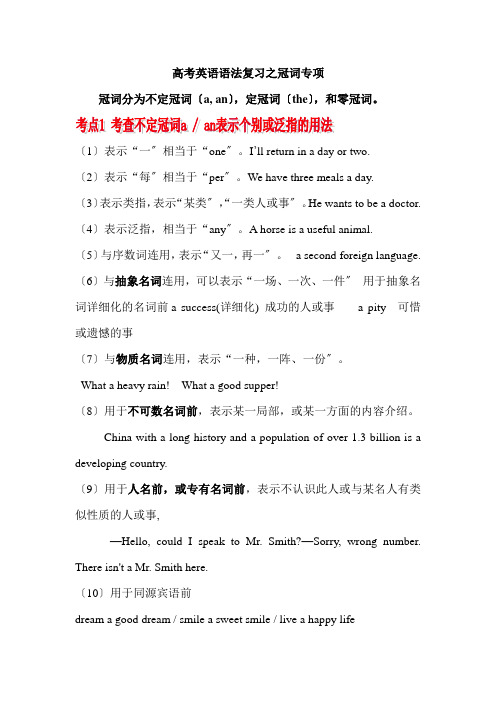
高考英语语法复习之冠词专项冠词分为不定冠词〔a, an〕,定冠词〔the〕,和零冠词。
〔1〕表示“一〞相当于“one〞。
I’ll return in a day or two.〔2〕表示“每〞相当于“per〞。
We have three meals a day.〔3〕表示类指,表示“某类〞,“一类人或事〞。
He wants to be a doctor. 〔4〕表示泛指,相当于“any〞。
A horse is a useful animal.〔5〕与序数词连用,表示“又一,再一〞。
a second foreign language. 〔6〕与抽象名词连用,可以表示“一场、一次、一件〞用于抽象名词详细化的名词前a success(详细化)成功的人或事 a pity 可惜或遗憾的事〔7〕与物质名词连用,表示“一种,一阵、一份〞。
What a heavy rain! What a good supper!〔8〕用于不可数名词前,表示某一局部,或某一方面的内容介绍。
China with a long history and a population of over 1.3 billion is a developing country.〔9〕用于人名前,或专有名词前,表示不认识此人或与某名人有类似性质的人或事,—Hello, could I speak to Mr. Smith?—Sorry, wrong number. There isn't a Mr. Smith here.〔10〕用于同源宾语前dream a good dream / smile a sweet smile / live a happy life〔11〕用于固定词组中a couple of, a bit, a great of , a lot of ,once upon a time, in a hurry〔1〕用于世上独一无二的事物名词前the universe, the moon, the Pacific Ocean〔2〕表示说话双方都理解的或上文提到过的人或事前Would you mind opening the door?〔3〕用于演奏西洋乐器前play the violin, play the guitar〔4〕用于形容词和分词前表示一类人the rich, the living, the wounded〔5〕表示“一家人〞或“夫妇〞〔比照上文的不定冠词用法9〕—Could you tell me the way to the Johnsons, please?—Sorry, we don’t have a Johnson here in the village.〔6〕与最高级连用Zhang Hua is the tallest of the three.〔7〕用于方位名词,身体部位名词He hit me on the shoulder.注意:表接触或打击身体某部位时,身体部位名词前通常加the.在“动词+sb.+介词+the+部位〞构造中,部位前用the,而且不能省略。
高中英语语法冠词归纳总结

高中英语语法冠词归纳总结冠词是英语语法中常见的一种词类,包括定冠词(the)和不定冠词(a/an)。
在句子中,冠词起到限定名词的作用,使句子结构更加明确且语义更加准确。
下面将对高中英语语法中的冠词用法进行归纳总结。
一、定冠词的用法1. 特指某个人或物时,使用定冠词“the”。
例: The book on the table is mine.这本书放在桌子上的那本是我的。
2. 对于已提到的事物或人,再次提及时使用定冠词“the”。
例: I bought a new car. The car is red.我买了一辆新车。
这辆车是红色的。
3. 用于表示某类人或物时,使用定冠词“the”。
例: The dog is a loyal animal.狗是忠诚的动物。
4. 在序数词和形容词最高级前使用定冠词“the”。
例: She is the first person to arrive.她是第一个到达的人。
5. 在乐器、船、山脉等特定名称前使用定冠词“the”。
例: He can play the piano very well.他弹钢琴弹得很好。
二、不定冠词的用法1. 用于单数可数名词前表示泛指,使用不定冠词“a/an”。
例: I want to buy a book.我想买一本书。
2. 在职业、国籍、宗教等名词前使用不定冠词“a/an”表示一个人或物。
例: She is an English teacher.她是一名英语老师。
3. 在表示时间、速度、频率等的名词前使用不定冠词“a/an”。
例: He runs at a speed of 10 kilometers per hour.他以每小时10公里的速度跑步。
三、无冠词使用1. 用作一般概念、抽象名词、学科名词及表示饮食、旅行、疾病等名词时,通常不使用冠词。
例: Mathematics is my favorite subject.数学是我最喜欢的科目。
高中英语语法讲解及练习

高中英语语法讲解及练习一、冠词冠词的用法在英语学习中较为复杂,千头万绪,尤其是惯用法,请同学们平时学习时注意积累。
以下不过是谈谈冠词的一些常规的用法。
一、不定冠词的用法:1、泛指人或事物的类别,相当于any, 如:A hammer is tool. A steel worker makes steel.2、泛指某人或某物。
A boy is waiting for you. There is a book on your desk.3、表one或every。
We work 8 hours a day. I go home twice a month.4、表示the same 的意思。
Birds of a (= the same) feather flock together; people of a kind come together.5、用在不可数名词前a)(用在物质名词前)一种,一份A large coffee for me. It was a wonderful tea.b)(用在某些表示风、雨等的名词前)It was clear daylight now and a fine rain was falling. There is a cold wind this morning.c)(用在抽象名词前)一种That is a great disappointment. It’s a pleasure to work with you.6、(用在某些专有名词前)某个叫…的人,一张…的画,一个象…的人等。
I saw a Mrs. Smith on the 12th at 2:00. He had a Van Gogh in thedining-room.What a strange London they saw! He’s a living Lei Feng.7、用于某些固定词组中。
a few, a little, a good many, a lot of, all of a sudden, as a rule, have a cold等。
高考英语冠词讲解及历年高考冠词真题试题答案及解析

冠词(一)冠词的分类:冠词分为不定冠词"a,an"、定冠词"the"和零冠词三种。
(二)不定冠词的用法:1. 用于可数名词的单数形式之前,表示"一"There is a tiger in the zoo. 动物园里有一只老虎。
2. 表示一类人或事物A tiger can be dangerous. 老虎可能有危害性。
※定冠词the+形容词(也代表一类人)The poor are still poor.3. 表示"某一个"或者是指想要成为“像...样的人物”的意思A Mr Smith wants to see you. 有一位叫史密斯的先生要见你。
He wants to be a Max in the future.他将来想成为像马克思一样的人。
4. 表示"同一";"每一"的意思They are nearly of an age. 他们几乎同岁。
We go swimming four times a week. 我们每周去游泳四次。
5. 第一次提到的人或事物,但不特殊指明是哪一个Long long ago there was an old king who had a very beautiful daughter.6.用在某些表示数量的词组中:a lot of 很多 a couple of 一对 a great many 很多7.用于习惯用语中all of a sudden 突然in fact=as a matter of fact 事实上as a result 结果have a cold 感冒have a good(nice,wonderful,great)time 玩得兴奋(三)定冠词用法:1. 用以特指某(些)人或某(些)事物This is the house where Luxun once lived. 这是鲁迅曾经住过的房子。
冠词a,an,the的用法及练习题(含答案)

冠词a, an, the的用法及练习要点:冠词是一种虚词,放在名词的前面,帮助说明名词的含义。
冠词分不定冠词(The Indefinite Article)和定冠词(The definite Article)两种。
a (an)是不定冠词,a用在辅音之前:如a book, a man; an用在元音因素之前,如:an old man, an hour, an interesting book等;the是定冠词;零冠词,是指不使用冠词的情形。
一、不定冠词a(an)的用法:1.表示“一个”、“某一个”、“每一”、“再一、又一”或“同一,相同”等,但没有one强烈。
e.g.: Rome is not built in a day. 罗马不是一天建成的。
A Mr. Smith is waiting for you at the school gate. 一个叫Smith的先生在校门口等你。
He usually works eight hours a day. 他通常一天工作8小时。
You can try it a second time if you fail. 如果你失败了,可以再试一次。
They are of an age. 他们的年龄一样大。
Birds of a feather flocks together. 物以类聚,人以群分。
2.泛指某一类人或物,意为“任何一个,任一”。
e.g.: A square has four sides. 正方形有四条边。
A car must be insured. 汽车一定要上保险。
A soldier must obey orders. 军人必须服从命令。
3.当物质名词具体化表示“一(类、阵、份)”等;抽象名词具体化为“…的人或者事”时。
e.g.: Green tea is a wonderful tea. 绿茶是一种极好的茶。
We don’t have much rain here, but last night we had a heavy rain.我们这里雨水不多,但昨晚下了一场大雨。
英语语法:冠词讲解及练习题(附答案)

英语语法:冠词讲解及练习题(附答案)冠词是一个虚词,它置于名词之前,限定名词的意义.冠词可分为定冠词,不定冠词和零冠词三类。
下面学习啦小编为大家带来冠词语法讲解及练习题,欢迎大家学习!一、冠词语法讲解1. a用于辅音发音开头的词前, 如:a book; an用于元音发音开头的词前,如:an apple, an hour. 请区别:a useful machine, an umbrella, a “u”, an “h”。
2.指上文提到过的人或物,用定冠词the。
3.在世界上独一无二的事物前用定冠词the. 如:the sun, the moon, the earth。
4.the用于序数词,表方位的名词和形容词最高级前。
the first, the best , in the south。
5.在复数姓氏前加the,表示××一家人,常看成复数。
如:the Browns。
6.在介词短语中常用定冠词the,如:in the box ,behind the chair。
7.不能用定冠词the的几个方面: (1)在节日、星期、月份、季节、年等词前不用冠词。
如:in summer, in August 请区别:in the spring of1945. (这里表示特指,故加the)(2)一日三餐和球类运动名不用冠词。
如:have breakfast ,play football(3)一些固定词组中,如:go to bed ,go to school, by bus ,at night. 8.在有些词组中,有冠词和无冠词意思不同,请注意区别:in front of 在…前面, in the front of 在…范围内的前部in hospital (生病)住院, in the hospital 在医院里。
二、练习题1. When Linda was a child,her mother always let her have ______ bed.A. the breakfast inB. the breakfast in theC. breakfast inD. breakfast in the2. Beyond ______ stars the astronaut saw nothing but ______ space.A. the,不填B. 不填,theC. 不填,不填D. the,the3. Alexander Graham Bell invented ________ telephone in 1876.A. 不填B. aC. theD. one4. After watching ____ TV,she played _____ violin for an hour.A. 不填,不填B. the,theC. the,不填D. 不填,the5. Many people are still in ____ habit of writing silly things in ____ public places.A. the,theB. 不填,不填C. the,不填D. 不填,the6. Paper money was in ____ use in China when Marco Polo visited the country in ____ thirteenth century.A. the,不填B. the,theC. 不填,theD. 不填,不填7. Have you seen ______ pen? I left it here this morning.Is it ____ black one? I think I saw it somewhere.A. a,theB. the,theC. the, aD. a, a8. She is _____ newcomer to ____ chemistry but she has already made some important discoveries.A. the,theB. the,不填C. a,不填D. a,the9. Many people agree that ___ knowledge of English is a must in ____ international trade today.A. a,不填B. the,anC. the,theD. 不填,the10. ______ usually go to church every Sunday.A. The BrownB. A BrownC. BrownsD. The Browns11. The train is running fifty miles ______.A. an hourB. one hourC. the hourD. a hour12. ___ earth we live on is bigger than___ moon.A. The, aB. The,theC. An, aD. An,the13. —What’s the matter with you ?—I caught ___ bad cold and had to stay in ___bed.A. a,/B. a,theC. a, aD. the,the14. —Do you know ___ lady in blue?—Yes. She is a teacher of a university.A. theB. aC. anD. /15. —Where’s ___ nearest supermarket?—It’s over there,just around the corner.A. aB. anC. theD. /16. The young man will work in ___ school as a maths teacher.A. theB. aC. anD. /17. Most of the representatives think that ______ the meeting was very successful.A. on whole ofB. on a wholeC. on the wholeD. on the whole that18. The investigators found that more should be done for ______ in India.A. those poorB. a poorC. poorD. the poor19. He grabbed me ______ and pulled me onto the bus.A. a armB. an armC. the armD. by the arm20. “How did you pay the workers?”“As a rule,they are paid ______.”A. by an yourB. by the hourC. by a hourD. by hours21. What _____ exciting football match! Our team beat Tom’s team at last.A. aB. anC. theD. /22. In the United States,Father’s Day falls on _____ third Sunday in _____ June.A. the,不填B. the, aC. 不填,theD. a,不填23. I have two dogs. ______ black one is two years old and ______ yellow one is three years old.A. A, aB. The, aC. The,theD. A. the24. ______ new bridge has been built over ______ Huangpu River.A. The, aB. A,/C. A,theD. An,an25. -What colour is ______ orange?-It’s _____ orange.A. an,anB. an,theC. an,/D. /,an参考答案:1. C2. A。
高中英语语法 冠词用法口诀和解释 附习题和答案详解
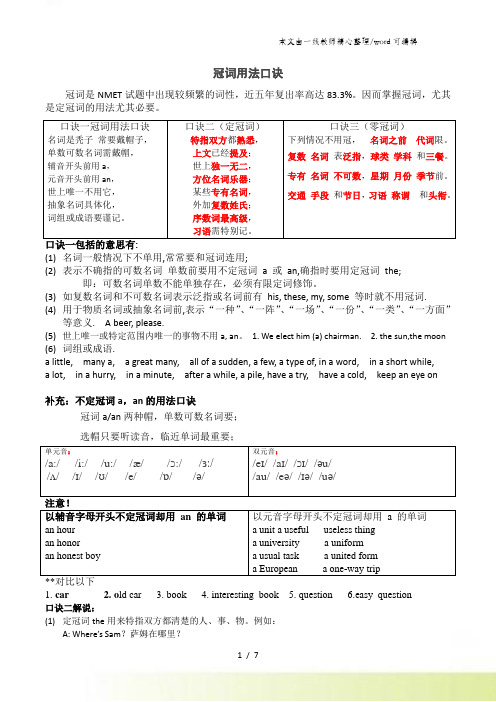
冠词用法口诀冠词是NMET试题中出现较频繁的词性,近五年复出率高达83.3%。
因而掌握冠词,尤其是定冠词的用法尤其必要。
口诀一冠词用法口诀名词是秃子常要戴帽子,单数可数名词需戴帽,辅音开头前用a,元音开头前用an,世上唯一不用它,抽象名词具体化,词组或成语要谨记。
口诀二(定冠词)特指双方都熟悉,上文已经提及;世上独一无二,方位名词乐器;某些专有名词,外加复数姓氏;序数词最高级,习语需特别记。
口诀三(零冠词)下列情况不用冠,名词之前代词限。
复数名词表泛指,球类学科和三餐。
专有名词不可数,星期月份季节前。
交通手段和节日,习语称谓和头衔。
(1)名词一般情况下不单用,常常要和冠词连用;(2)表示不确指的可数名词单数前要用不定冠词a 或an,确指时要用定冠词the;即:可数名词单数不能单独存在,必须有限定词修饰。
(3)如复数名词和不可数名词表示泛指或名词前有his, these, my, some 等时就不用冠词.(4)用于物质名词或抽象名词前,表示“一种”、“一阵”、“一场”、“一份”、“一类”、“一方面”等意义. A beer, please.(5)世上唯一或特定范围内唯一的事物不用a, an。
1. We elect him (a) chairman. 2. the sun,the moon(6)词组或成语.a little, many a, a great many, all of a sudden, a few, a type of, in a word, in a short while,a lot, in a hurry, in a minute, after a while, a pile, have a try, have a cold, keep an eye on补充:不定冠词a,an的用法口诀冠词a/an两种帽,单数可数名词要;选帽只要听读音,临近单词最重要;单元音:/a://i://u://æ/ /כ://ɜː/ /ʌ//ɪ//ʊ//e/ /ɒ//ə/双元音:/eɪ//aɪ//כɪ//əu/ /au//eə//ɪə//uə/以辅音字母开头不定冠词却用an 的单词an houran honoran honest boy 以元音字母开头不定冠词却用 a 的单词a unit a useful useless thinga university a uniforma usual task a united forma European a one-way trip1.car2. o ld car3. book4. interesting book5. question6.easy question 口诀二解说:(1)定冠词the用来特指双方都清楚的人、事、物。
- 1、下载文档前请自行甄别文档内容的完整性,平台不提供额外的编辑、内容补充、找答案等附加服务。
- 2、"仅部分预览"的文档,不可在线预览部分如存在完整性等问题,可反馈申请退款(可完整预览的文档不适用该条件!)。
- 3、如文档侵犯您的权益,请联系客服反馈,我们会尽快为您处理(人工客服工作时间:9:00-18:30)。
冠词用法一. 不定冠词的用法1. 表泛指,表首次提到的、不限定的人或物。
There is a book on the desk.2. a/an+ 单数n.表类别,指一类人或事物。
A horse is a useful animal.3.表one, a certain, every, the sameI’ll return in a day or two.A Mr. White is waiting for you downstairs.The doctor asked me to take the medicine three times a day.They are nearly of an age.4.用在抽象名词前,a + 抽象名词,即抽象名词具体化。
如:This little girl is a joy to her parents.It is a pleasure to talk with you.It is an honour to me to attend the meeting.a surprise/success/failure5.与物质名词连用,表示“一种,一阵、一份”。
What a heavy rain!What a good supper!Please give me a black coffee!6. 在同位语中,常用a/an+ n.(one)Mike and Lucy, a newly married couple, had a happy honeymoon in Paris.7. 用在某些固定词组中.after a while 过了一会儿all of a sudden 突然as a rule 通常as a result 结果,因此as a matter of fact 事实上as a whole 大体上at a loss 不知所措in a hurry 急忙in a way 在某种程度上in a word 总而言之put an end to… 结束…come to an end 结束come to a conclusion 得出结论have a good time 玩得愉快have a rest 休息一下have a cold 感冒have a word with 和…谈一谈make a living 谋生make a fire 生火make a fool of 愚弄take a walka knowledge of, a understanding of, a collection of8. 不定冠词的特殊位置1)as/so/too/how/however+ adj.+ a/an+单数n.So short a time.Too long a distance.2) what/such/half+ a/an+单数n.I have never seen such an animal.二. 定冠词的用法1.表特指的人或物Look at the blackboard.There is a book on the desk. The book is an English book.2. the+单数n.表类别The horse is a useful animal.3. 表世界上独一无二的事物,但若此类名词前有修饰成分,也可用a/anthe sun, the earth, the moon, the sky, the universea full moonbut: in nature, in space, in society, in history4. 用在普通名词构成的专有名词前以及江、河、湖、海、山川、群岛的名词前。
the United States, the Great Wall, the Yellow River, the Rocky Mountains,5. 用在序数词、形容词最高级、only, very, same前。
the second story, the largest room, the third longest river但:1)a/an+序数词表“又一,再一”;the+序数词表排序“第一,第二…..”Would you give me a second chance?2) a most +adj.最高级:very, the most +adj.最高级表“最….”a most beautiful picture= a very beautiful picture6. 用在方位名词前on the left, in the east / west7. 用在形容词或分词前表示一类人,作主语谓语用复数。
the poor / rich / dying / young / living / wounded8. 表“按…计算”by the yard/the dozen/the month/the day/the week/ton但:by size by time by weight9. 在姓氏复数形式前,表示全家人或夫妇二人。
The Smiths are sitting at the breakfast table10. 西洋乐器名词前Do you like to play the piano or the violin?11. 在表示发明物的单数名词前加定冠词The compass was invented in China four thousand years ago.12. 年代,朝代前In the 1870’s/1870s, the Tang Dynasty13. 动词+sb.+介词+the+身体部位He hit him in the face.beat sb. on the nose, take sb. by the arm, pat sb. on the head14. the+比较级表两者中“较….的”,a+比较级表“一个更…..的”He is the taller of the two boys.I don’t like the bike. I want a better one.15. 用在一些习惯用语中。
如:all the same 仍然all the time 一直all the year round 一年到头at the age of 在……岁时at the beginning of 起初; 开始at the end of 在……的尽头/末尾16. 定冠词位置定冠词通常位于名词或名词修饰语前,但放在exactly, just, all, both,double,half,twice等词之后,名词之前。
All the students in the class went out.班里的所有学生都出去了三. 不用冠词的情况(零冠词)1. 专有名词前China , America, John,2. 可数名词前有物主代词、指示代词、不定代词、名词所有格限制时This book is mine.3. 季节、月份、星期、节日、一日三餐名称前spring, summer, autumn / fall, winter, Sunday, October, National Daybut: in the spring of that year,I met him on a Monday last month.We had a wonderful supper.4. 称呼语,表示头衔的名词作表语、补足语及同位语时What’s this, Mother?He was made monitor.George W. Bush is president of the USA.5. 学科名词,球类、棋类名词前Do you study mathematics?He likes playing football / chess.6. 不可数名词、复数名词表泛指前Water is very important.Computers are widely used in our daily life.7. 在与by连用的交通工具名称前by car( bus, train, water, air, land)8. 某些固定词组中day and night, brother and sister, hour after hour, here and there9. as引导的让步状语从句中,作表语的名词不带冠词。
Child as she is, she knows a lot of French.10. 系动词turn(作“变成”解)后作表语的单数可数名词前习惯不用冠词。
The young girl has turned writer.= The young girl has become a writer11.no与such连用时应放在such之前,such后面的名词不用冠词。
No such thing has ever happened in this village12. man “人类”nature “自然”前不用冠词。
13. 常见纯不可数名词,不与a/an 连用。
fun, weather, advice, progress, baggage, luggage, furniture, equipment, space, health, wealth, word=news, information, luck注意:有无冠词的区别at table 在进餐at the table 在桌子旁边at desk 在读书at the desk 在课桌旁at school 在上学at the school 在学校里in class 在上课in the class 在班级里面in bed 卧床in the bed 在床上in prison 坐牢in the prison (因事)在监狱in hospital 住院in the hospital (因事)在医院go to school 去上学go to the school (因事)去学校go to bed 上床睡觉go to the bed 在床上go to hospital 去看病go to the hospital 去医院take place 发生take the place 代替in place of 代替in the place of 在...的地方in case of 万一in the case of 就...来说out of question 毫无疑问out of the question 完全不可能1. He missed ___ gold in the high jump, but will get ___ second chance in the long jump.A. the; theB. 不填; aC. the; aD. a; 不填2.Carl is studying food science at college and hopes to open up meat processing factoryof his own one day.A. / ;aB. / ;theC. the ; aD. the ; the3. Sam has been appointed _____ manager of the engineering department to take ____ place of George.A./,/B. the,/ C the; the D./, the4. Sarah looked at finished painting with satisfaction.A.不填;aB. a; theC. the; 不填D. the; a5. Being able to afford ______ drink would be ______ comfort in those tough times.A. the; theB. a; aC. a; 不填D. 不填; a6. The Smiths don’t usually like staying at ___ hotels, but last summer they spent a few days at a very nice hotel by ____ sea.A. /; aB. the; theC. /; theD. the; a7.I woke up with ______ bad headache, yet by ____ evening the pain had gone.A. the; theB. the; anC. a; theD. a; an8. We are said to be living in ____ Information Age, ____ time of new discoveries and great changes.A. an; theB. 不填; theC. 不填; aD. the; a9. The development of industry has been _____ gradual process throughout _____ human existence, from stone tools to modern technology.A. 不填; theB. the; aC. a; 不填D. a; a10. The “Chinese Dream” is ______ dream to improve people’s well-being and ______ dream of harmony, peace and development.A. the; aB. a; aC. a; theD. the; the11. Animals are obviously ______ lower form of life than _______ man.A. a ; /B. the ; theC. a ; theD. / ; /12. It was ______ cold winter night and the moon was shining brightly across ____ night sky.A. 不填;aB. a; theC. the; aD. the; 不填13. Marco Polo is said to have sailed on ___ Pacific Ocean on his way to Java in ___thirteenth century.A. the; aB. a; /C. /; theD. the; the14. India attained ______ independence in 1947, after ______ long struggle.A.不填;aB. the; aC. an;不填D. an; the15. People develop ______ preference for a particular style of learning at ______ early age and thesepreferences affect learning.A. a; anB. a; 不填C. 不填; theD. the; an16. The parents were shocked by ______ news that their son needed ______ operation on his knee.A. a;/B. the; /C. the; anD. a; an17. Four and______ half hours of discussion took us up to midnight, and______ break for cheese,chocolate and tea with sugar.A. a; aB. the; theC.不填;theD. a;不填18. They chose Tom to be ________ captain of the team, because they knew he was ____ smart leader.A. a; theB. the; theC. the; aD. a; a19. ________ village where I was born has grown into ________ town.A. The; aB. A; theC. The; theD. A; a20. Life is like ________ ocean: only ________ strong-willed can reach the other shore.A. an; theB. the; aC. the ;/D. / ; a21.The paper is due next month,and I am working seven days ____week,often long into ___night.A.a; the B.the; 不填C.a; a D.不填;the22. I can't tell you ________ way to the Wilsons' because we don't have ________ Wilson here in the village.A. the; aB. a; /C. a; theD. the; /CADCB CCDCB ABDAA CACAA AA。
